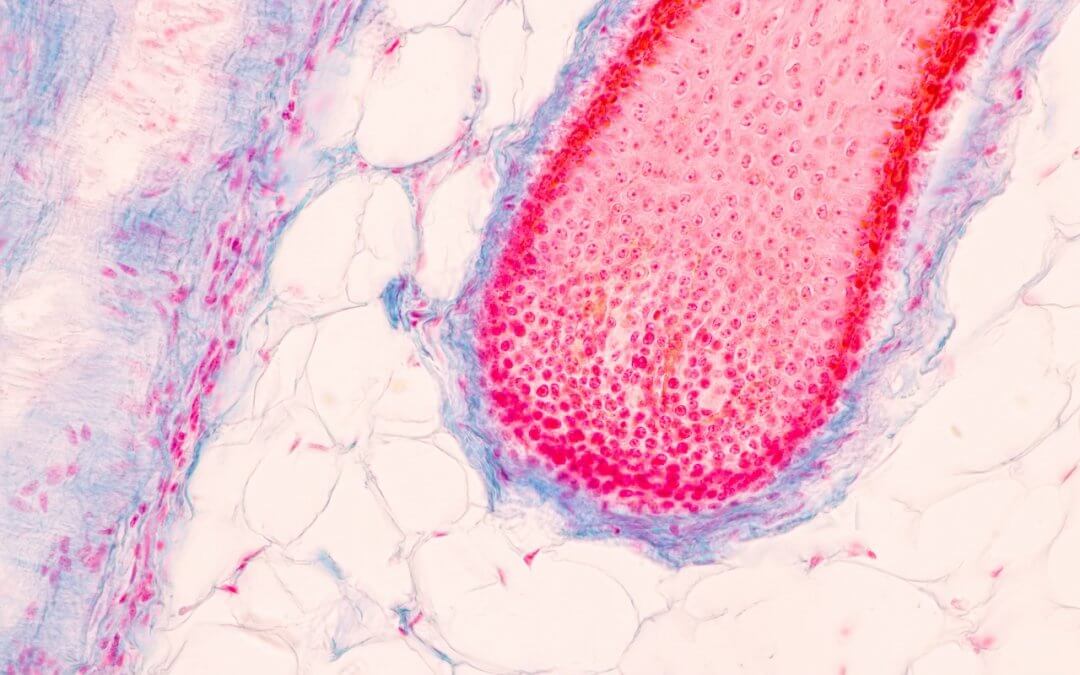Although hair loss is common, it can have a huge impact on a person’s self-esteem and, subsequently, their physical and mental wellbeing.
New trials exploring the potential applications of stem cells in treating hair loss offer hope for those who are suffering both now and in the future.
What causes different types of hair loss?
The root causes of hair loss in both men and women are varied.
Amongst the most common type of hair loss is androgenetic alopecia (otherwise known as pattern baldness in both men and women).
Although the essential causes of this form of hair loss are somewhat unknown, experts understand androgenetic alopecia to arise from the overstimulation of hair follicles by a hormone called androgen.
This in turn leads to a shorter growth cycle and results in hair thinning and loss. [1]
Another fairly common disorder affecting hair follicle growth is alopecia areata. This auto-immune disease causes a breach in the immune-privilege afforded to hair follicles.
Other causes of hair loss include the effects of increased cortisol levels from stress, trauma and grief, along with the side effects of certain medical treatments, like chemotherapy. [2]
What options are currently available?
Because of the commonality of hair loss, demand for treatments to regrow, replenish or transplant hair are correspondingly widespread.
At the moment, treatments for hair loss include medications like Finasteride and Minoxidil, strictly topical medications like prostaglandins and cetirizine, along with Low Level Laser Therapy and Platelet Rich Plasma Therapy.
There are also a wide array of natural ingredients thought to help prevent hair loss, like niacin, sage and green tea. [3]
In recent years there have also been significant advances in research into the possible uses of stem cells in treating hair loss.
The application of stem cells from the hair follicle, adipose tissue and from umbilical cord blood for hair replenishment or even regrowth are all currently being investigated in over a thousand clinical trials. [4]
Using stem cells from hair follicles
The mesenchymal stem cells that differentiate into hair follicles require chemical activation to begin the process of differentiation.
When this chemical activation doesn’t happen, follicular degeneration begins, and hair growth stops.
Researchers at the University of California, Los Angeles have identified two drugs that can cause this activation in mesenchymal stem cells harvested from hair follicles. [5]
By using one drug, called RCGD423, researchers were able to activate a signalling pathway that increased production of lactate, driving the activation of the follicle stem cells and resulting in increased hair growth.
The other drug, UK5099, was shown to also increase the production of lactate by preventing pyruvate from entering the mitochondria of the hair follicle stem cells, increasing hair growth in mice.
There have also been attempts to inject hair follicle stem cells directly into the scalp.
Researchers in Italy and Albania took biopsies of the ‘bulge’ of the hair follicle (a niche at the bottom of the follicle containing stem cells) which were then trimmed and centrifuged to separate the cells. [6]
These cells were then injected into a site on the scalp and the results monitored over 23 weeks.
Researchers found significant improvements in the hair density and hair count compared to placebo areas, suggesting that this method for treating hair loss may have huge potential for other hair loss sufferers.
Treating hair loss with adipose tissue
Adipose tissue, otherwise known as body fat, is a rich source of mesenchymal stem cells. These cells can be extracted from where they commonly reside subcutaneously (beneath the skin) in deposits around the thighs and buttocks.
These cells can be extracted using liposuction or prepared as a conditioned media. This can then be injected directly into the scalp over the course of several rounds to help encourage hair growth.
In a study published in 2015, researchers found that the application of adipose-derived stem cell conditioned media to the balding scalps of 27 sufferers of female pattern hair loss generated encouraging results.
After 12 weeks of treatment, the researchers observed that both hair density and hair growth increased notably, suggesting the pioneering stem cell treatment’s potential efficacy. [7]
Hair loss treatment using umbilical cord blood
Researchers in China and the US investigated a possible method for treating alopecia areata. [8]
Their method, called ‘Stem Cell Educator’ therapy, involved the circulation of a patient’s blood through a closed-loop system with multipotent cord blood stem cells, and then returned to them.
This method aimed to replenish rather than replace the existing follicles by providing them with a ring of protection from the immune system; essentially reversing the breach of the hair follicles’ immune-privilege as occasioned by the condition.
Results indicated significant hair regrowth for patients in the trial; a promising indication of a potential treatment for alopecia areata, a disease that currently is without cure.
While there is still a long way to go before any stem cell treatments get official approval, these examples show that the future of hair loss treatments looks very much like an increase in the use of various stem cell therapies.
To learn more about the regenerative potential offered by stem cells, sign up below and receive a free Welcome Pack!
Sources
[1] National Library of Medicine (2023, July 27). Androgenetic alopecia. Medline Plus.
FIND OUT MORE, REQUEST YOUR WELCOME PACK TODAY
All you need to know to make an informed decision.
Provide your contact details to request:
– Complete Welcome Pack and Parent’s Guide
– Information via email
– Contact from our specialist advisors








